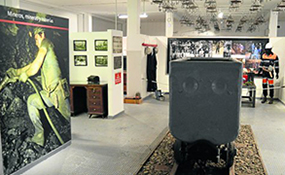The Sotón Shaft expands its contents with a Center for Mining Experiences and Memory and one Memorial dedicated to the miners who died in Asturias
29 March 2016 | Oviedo

- HUNOSA exhibits historical funds from the company, as well as documents from its Archive and a number of artifacts collected in the shafts
- The Sotón Shaft increases its cultural and leisure offer with the opening of the Center for Mining Experiences and Memory, which is housed in the former bathrooms and electricity workshop building at the mining site of San Martín del Rey Aurelio
- During the first days the new facilities have been open, 1,667 persons visited the mining shaft
HUNOSA’s Sotón Shaft, an historical referent for Asturian coal mining, which was declared in 2014 as a heritage of cultural interest (BIC in Spanish) under the monument category, and which became last summer the first mine under operation in Europe to organize guided visits into a depth of almost six hundred meters, has just expanded its cultural offer with the opening of the Center for Mining Experiences and Memory.
This area, which has been set up in the former bathrooms and electricity workshop building at the mining facility of San Martín del Rey Aurelio, exhibits the Company’s historical funds, documents from its Archives, as well as a number of coal mining artifacts, machinery and tools, which have been collected from the Company’s mining shafts.
The goal is making known, through interactive contents and through a guided visit suited to persons of all ages, the work in the mines and the recent history of both HUNOSA and coal mining in Asturias. Thus, visitors will be able to experience total darkness in the mine, integrate themselves through a stamp into the mining historical images, to push a coal dump car, or walk around the Bathroom House as it was left when it closed down.
The Center will stay open, from Tuesdays to Sundays, from 10:00 am to 2:00 pm , and from 3:30 to 6:00 pm. The cost of the admission ticket will be of 3.5 € for adults, and of 2 € for children, students, pensioners, unemployed and disabled persons.
Memorial to the miners who died in Asturias
This is not the only novelty seen these days in the facilities of the Sotón Shaft. At one of the squares of the coal mining facility has just opened to the public the Memorial which pays homage to the thousands of workers who died in work-related accidents in coal mining in Asturias.
Although by now are included only the names of the 540 miners who died in HUNOSA’s mines – the company was incorporated in 1967 – the project aims to progressively include the workers from other coal mining companies which were in operation before the incorporation of the coal mining company of Grupo SEPI.
Due to the scale of the project – it must be borne in mind that some researchers estimate that more than five thousand persons died working in Asturian coal mines -, HUNOSA is opening up channels for the participation of those families, researchers and neighbors who wish to supply new documentation. This collaboration is essential for keeping the Memorial growing and thus for it to integrate all those coal miners who died in a work-related accident and also, for contrasting the data obtained.
Also for this purpose of collaborating in the analysis of the data collected, the Memorial will have at its disposal an advising board which at first will be made up by Mr. Santiago González Romero, Head of the Mining and Industry Museum; Mr. Pedro Fandos, geologist and an expert on the history of Asturian coal mining; Mr. Guillermo Laine, mining engineer and an expert on the recovery of the mining industrial heritage; Mr. Mario García, mining technician and an expert on the history of mining accidents; Ms. Clementina Álvarez, head of HUNOSA’s documentation and archives department; and Mr. Eduardo Urdangaray, head of the Mining Historical Archive.
The timetable for visiting the Memorial is the same as that of the Mining Experiences Center, and admission is free. The only requirement will be to give the name and the national identification number (DNI) at the entrance for security reasons.
In the first days during which the new facilities have stayed open – which coincided with the Easter festivities – a total of 1,667 persons visited the mining shaft, which has already become a magnet for cultural tourism in the coal mining region of Central Asturias.
HUNOSA is now working on expanding to the weekends and holidays the visits to the interior of the mine, which up to now can only take place during the working hours.
HUNOSA and Grupo SEPI
HUNOSA belongs to Grupo SEPI, a corporate holding which includes a total of 16 state-owned companies in which it has direct, majority shareholding participations, with a workforce of around 73,000 professionals in 2014; the Spanish state-owned television and radio corporation, Corporación Radiotelevisión Española, which is attached to SEPI, and one public foundation. Equally, SEPI has direct minority shareholdings in a further ten companies, and indirect shareholdings in more than one hundred companies







